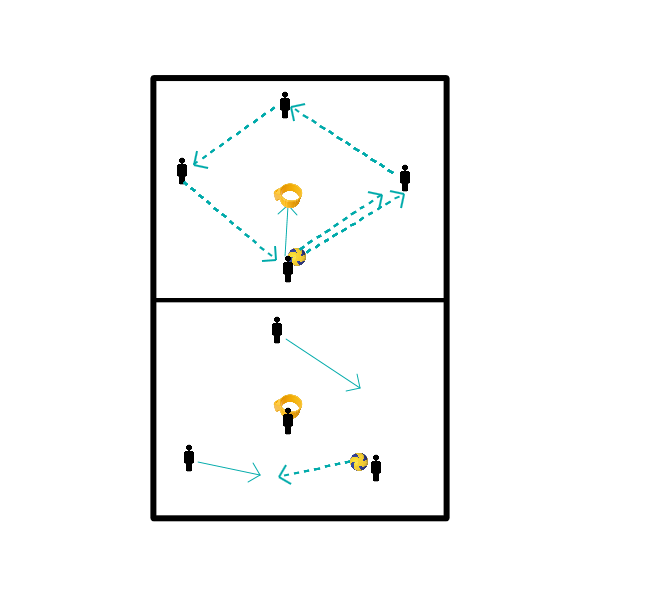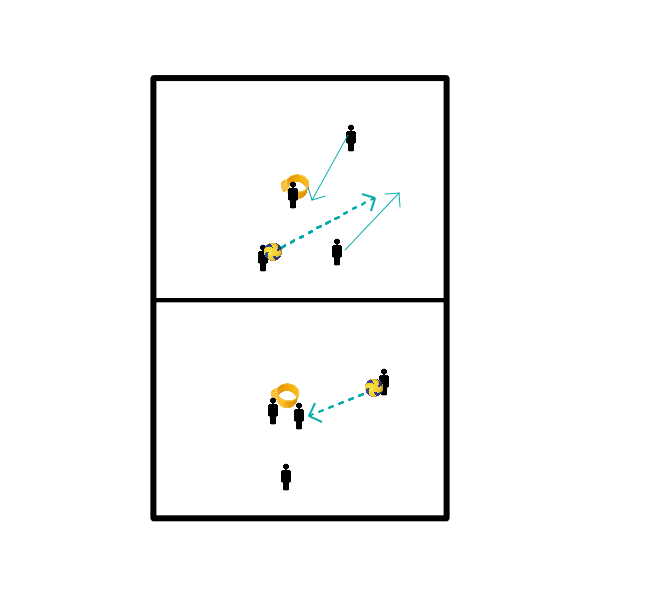Korfball drills for technique defense
3 attackers with 1 ball and 1 defender. In a small square, the attackers have to play around as often as possible. When the defender intercepts (or just touches the ball) the count starts over. The defender who has had the least number of passes within 1 minute wins.
- Make 2 squares of 4.
- The attack takes the ball from the trainers.
- When the defence has intercepted the ball, they first pass it back to the trainers.
- When a goal is scored, the team gets a bonus and can take the ball back out.
2 children are standing near a basket. One attacker and one defender.
- The attacker may move around the basket, towards the basket and away from the basket.
- The defender always stays with his back to the basket and follows the defender.
- Do this for 20 seconds at a time.
For some extra difficulty, the attacker can do tempo changes.
Start line-up
Three groups at the first pawns.
Exercise
The first in line runs to the hoop and goes through the hoop from the bottom, so the hoop goes over their head. Then he goes through the defense stance to pawn two. Turn around and make short passes (left, right) to the next pawn. From there, start to pass the ball. After that, go to the pole for a shot. Then back to the start, tap, next. There are two points per person. First team with six points wins.
Defensive stance:
Back out and through the knees with your arm up.

Start line-up
Two groups at the first two pawns.
Exercise
The first one in line runs to the basket lying on the ground and goes through it, so the basket goes over their head. Then he runs through the defence posture to pawn two and turns around it 4 times. Finally, he runs to pawn 3 and tries to score (3 attempts) before he can run back to pawn 1 and hit the next one in line.
Defensive stance:
Backwards and through the knees with your arm up.
Distance setup:
Hoop from pawn 1: 5 meters.
Pawn 2 from hoop: 5 meter.
Pawn 3 from pawn 2: 5 meter.
Pole from pawn 3: 4 meters.

Start line-up
Two groups at the first two pawns.
Exercise
- The first in line runs to the hoop and goes through the hoop from the bottom, so the hoop goes over their heads.
- Then he runs through the defence posture to pawn two and circles this in 4 circles.
- Finally, he runs to pawn 3 and scores before he can run back to pawn 1 and tap the next one in line.
Set-up distance:
Hoop from pawn 1: 5 meters.
Pawn 2 from the hoop: 5 meter.
Pawn 3 from pawn 2: 5 meter.
Pole from pawn 3: 4 meter.

- Make 2 squares of 4.
- The attack takes the ball from the trainers.
- When the defence has intercepted the ball, they first pass it back to the trainers.
- When a goal is scored, the team gets a bonus and can take the ball back out.
Do give orders, for example:
- Start in a diamond. Let the ball go around 1 time.
- The player in front throws the ball next to him/her one more time and catches it.
- The other players continue playing. The player who has the ball now chooses whether he wants to throw to the left or to the right. The other players run to the ball to pick it up. The ball is thrown and the player immediately runs a long line.
The long line is nudged and the thrower comes alongside. The other player walks behind the basket to walk into the support. The other two are going to attack.


Inshort: practise various forms of the shot in a fun competition format.
Organisation: each group a basket and a ball, the baskets are preferably (but not absolutely necessary) arranged in a circle or rectangle. The number of people per group is less important (all groups should be about the same size).
Pawns set up at 1,3,5 metres
The first assignment for the groups is: make 10 goals. When you are done, the creator of the last goal goes to the trainer to get the next assignment. Which group will have completed all assignments first?
The trainer walks around the room, encouraging or correcting the players. He has a piece of paper with a list of assignments. When someone comes to get the next assignment, first ask him which assignment he just completed (after a while this can vary considerably) and then give the next one. Here's an example: 10 walk-through balls, 15 penalty shots, 5 shots from 8 meters, 10 walk-through balls from behind the basket, 5 dodgeballs next to the post, 10 shots from 6 meters. Everything is possible of course, a lot of momentum comes from keeping the number of goals to be scored small.
Tasks:
- 6 scores from 2,5 meter in front of the basket
- 6 scores from 1 meter in front of the basket
- 6 scores from 6 meter in front of the basket
- 6 scores from 2,5 meter behind the basket
- 6 scores from 1 meter behind the basket
- 6 scores from 6 meters behind the basket
Start line-up
Two groups at the first two pawns.
Exercise
The first in line runs to the hoop and goes through the hoop from the bottom, so the hoop goes over their heads. Then he runs through the defence posture to pawn two and circles this in 4 circles. Finally, he runs to pawn 3 and scores before he can run back to pawn 1 and tap the next one in line.
Distance set up:
- Hoop from pawn 1: 5 meters.
- Pawn 2 from the hoop: 5 meter.
- Pawn 3 from pawn 2: 5 meter.
- Pole from cone 3: 4 meter.

Setup: O v * * = pilon O = basket
* v O
[Make
sure that they first pass the ball before passing it.
Distance between the pile and the basket is +/- 10 meterAt
each pile there is one person with the ballAt
+/- 4 meter from the pile there is one defender.
The player tries to pass the ball. By changing tempo she tries to pass the defender first. Defender follows, but lets her pass. From pole 1 the attacker moves on to pole 2 and makes a new attempt at pole 2.
Variation:
- 2 attackers at the same time
- When scoring twice, switch to pass.
- Defender goes for preventing shot.
- Attacker can choose for walk through, dodge and/or distance with step behind
- adjust time
- multiple posts/pillars/players
Setup: O v * * = pilon O = basket
* v O
- Distance between the pile and the basket is +/- 10 meter.
- At every pole stands 1 attacker with the ball.
- At 1 meter from the pylon stands 1 defender (you must be able to touch the attacker by the shoulder).
- The player tries to pass the ball.
- By changing tempo she tries to pass the defender first.
- Defender follows, but lets her pass.
- From pole 1 the attacker continues to pole 2 and makes a new attempt at pole 2.
- We do this for 1 to 2 minutes per person.
Variation:
- 2 attackers at the same time
- When scoring twice, switch to pass.
- Defender goes for preventing shot. Attackers can choose for walk through ball, dodge and/or distance with step behind.
- adjust time
- Multiple posts/pillars/players.
! Form two groups. The attacker receives a vest.
This is louging in a korfball way. One person is the attacker, she/he starts with one defender. Within a playing area she/he must try to get free. In front of the box is the attacker. She/he has to make sure the ball gets to the attacker in the box. The other players stand aside. If the attacker receives the ball without the defender intercepting, a defender comes on board.
- Running free
- Throw
- Contact







